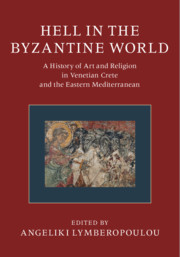 Hell in the Byzantine World
Hell in the Byzantine World 3 - Hell on Crete
from Part I - Crete
Published online by Cambridge University Press: 02 October 2021
Summary
Angeliki Lymberopoulou identifies the basic characteristics of the imagery of Hell (the Place of Hell Formed by the River of Fire, Individual Sinners and Communal Punishments), but highlights the absence of iconographical standardisation. Since Hell signified divergence from the preaching of the Orthodox Church and highlighted to the faithful the consequences of sin, it was often formed according to the degree to which communities were affected by each transgression. As such, the professions depicted offer us valuable insight into the economic structure of the society and the role of women within a male-dominant society. To highlight the significance of repentance, individual sinners are often placed at eye level, creating a telling proximity between sinners and churchgoers, who are brutally reminded of the significance their own deeds could have in determining their final destination – Paradise or Hell. It can be argued that Cretan imagery of Hell acts as the Church’s call for repentance from the faithful, encouraging social disapproval of those who transgress against penal and ethical law.
Keywords
- Type
- Chapter
- Information
- Hell in the Byzantine WorldA History of Art and Religion in Venetian Crete and the Eastern Mediterranean, pp. 117 - 190Publisher: Cambridge University PressPrint publication year: 2020
- 2
- Cited by
